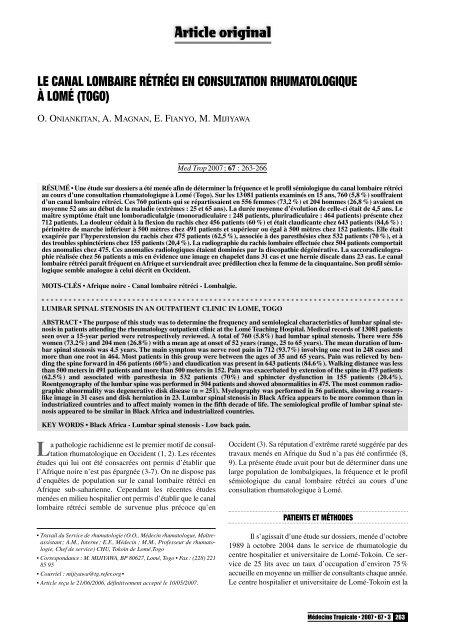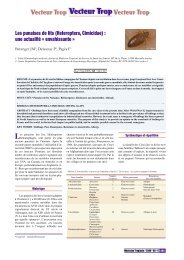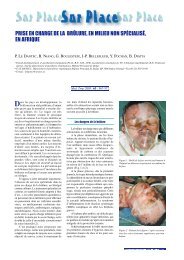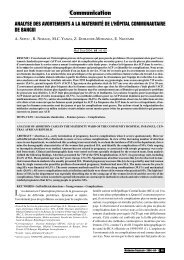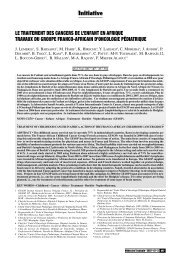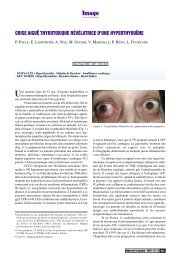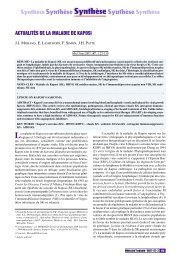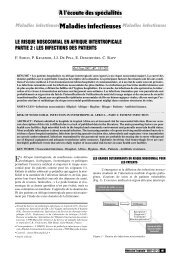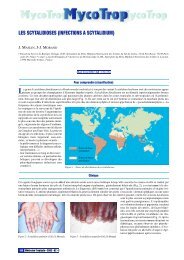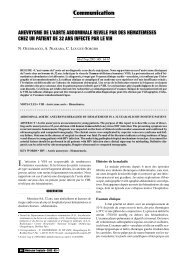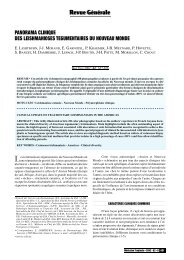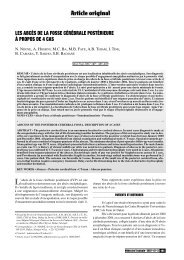le canal lombaire rétréci en consultation rhumatologique à lomé (togo)
le canal lombaire rétréci en consultation rhumatologique à lomé (togo)
le canal lombaire rétréci en consultation rhumatologique à lomé (togo)
Create successful ePaper yourself
Turn your PDF publications into a flip-book with our unique Google optimized e-Paper software.
Artic<strong>le</strong> original<br />
LE CANAL LOMBAIRE RÉTRÉCI EN CONSULTATION RHUMATOLOGIQUE<br />
À LOMÉ (TOGO)<br />
O. ONIANKITAN, A. MAGNAN, E. FIANYO, M. MIJIYAWA<br />
RÉSUMÉ • Une étude sur dossiers a été m<strong>en</strong>ée afin de déterminer la fréqu<strong>en</strong>ce et <strong>le</strong> profil sémiologique du <strong>canal</strong> <strong>lombaire</strong> <strong>rétréci</strong><br />
au cours d’une <strong>consultation</strong> <strong>rhumatologique</strong> <strong>à</strong> Lomé (Togo). Sur <strong>le</strong>s 13081 pati<strong>en</strong>ts examinés <strong>en</strong> 15 ans, 760 (5,8%) souffrai<strong>en</strong>t<br />
d’un <strong>canal</strong> <strong>lombaire</strong> <strong>rétréci</strong>. Ces 760 pati<strong>en</strong>ts qui se répartissai<strong>en</strong>t <strong>en</strong> 556 femmes (73,2%) et 204 hommes (26,8%) avai<strong>en</strong>t <strong>en</strong><br />
moy<strong>en</strong>ne 52 ans au début de la maladie (extrêmes : 25 et 65 ans). La durée moy<strong>en</strong>ne d’évolution de cel<strong>le</strong>-ci était de 4,5 ans. Le<br />
maître symptôme était une lomboradiculalgie (monoradiculaire : 248 pati<strong>en</strong>ts, pluriradiculaire : 464 pati<strong>en</strong>ts) prés<strong>en</strong>te chez<br />
712 pati<strong>en</strong>ts. La dou<strong>le</strong>ur cédait <strong>à</strong> la f<strong>le</strong>xion du rachis chez 456 pati<strong>en</strong>ts (60%) et était claudicante chez 643 pati<strong>en</strong>ts (84,6 %) :<br />
périmètre de marche inférieur <strong>à</strong> 500 mètres chez 491 pati<strong>en</strong>ts et supérieur ou égal <strong>à</strong> 500 mètres chez 152 pati<strong>en</strong>ts. El<strong>le</strong> était<br />
exagérée par l’hyperext<strong>en</strong>sion du rachis chez 475 pati<strong>en</strong>ts (62,5%), associée <strong>à</strong> des paresthésies chez 532 pati<strong>en</strong>ts (70%), et <strong>à</strong><br />
des troub<strong>le</strong>s sphinctéri<strong>en</strong>s chez 155 pati<strong>en</strong>ts (20,4%). La radiographie du rachis <strong>lombaire</strong> effectuée chez 504 pati<strong>en</strong>ts comportait<br />
des anomalies chez 475. Ces anomalies radiologiques étai<strong>en</strong>t dominées par la discopathie dégénérative. La saccoradiculographie<br />
réalisée chez 56 pati<strong>en</strong>ts a mis <strong>en</strong> évid<strong>en</strong>ce une image <strong>en</strong> chape<strong>le</strong>t dans 31 cas et une hernie disca<strong>le</strong> dans 23 cas. Le <strong>canal</strong><br />
<strong>lombaire</strong> <strong>rétréci</strong> paraît fréqu<strong>en</strong>t <strong>en</strong> Afrique et survi<strong>en</strong>drait avec prédi<strong>le</strong>ction chez la femme de la cinquantaine. Son profil sémiologique<br />
semb<strong>le</strong> analogue <strong>à</strong> celui décrit <strong>en</strong> Occid<strong>en</strong>t.<br />
MOTS-CLÉS • Afrique noire - Canal <strong>lombaire</strong> <strong>rétréci</strong> - Lombalgie.<br />
LUMBAR SPINAL STENOSIS IN AN OUTPATIENT CLINIC IN LOME, TOGO<br />
ABSTRACT • The purpose of this study was to determine the frequ<strong>en</strong>cy and semiological characteristics of lumbar spinal st<strong>en</strong>osis<br />
in pati<strong>en</strong>ts att<strong>en</strong>ding the rheumatology outpati<strong>en</strong>t clinic at the Lomé Teaching Hospital. Medical records of 13081 pati<strong>en</strong>ts<br />
se<strong>en</strong> over a 15-year period were retrospectively reviewed. A total of 760 (5.8%) had lumbar spinal st<strong>en</strong>osis. There were 556<br />
wom<strong>en</strong> (73.2%) and 204 m<strong>en</strong> (26.8%) with a mean age at onset of 52 years (range, 25 to 65 years). The mean duration of lumbar<br />
spinal st<strong>en</strong>osis was 4.5 years. The main symptom was nerve root pain in 712 (93.7%) involving one root in 248 cases and<br />
more than one root in 464. Most pati<strong>en</strong>ts in this group were betwe<strong>en</strong> the ages of 35 and 65 years. Pain was relieved by b<strong>en</strong>ding<br />
the spine forward in 456 pati<strong>en</strong>ts (60%) and claudication was pres<strong>en</strong>t in 643 pati<strong>en</strong>ts (84.6%). Walking distance was <strong>le</strong>ss<br />
than 500 meters in 491 pati<strong>en</strong>ts and more than 500 meters in 152. Pain was exacerbated by ext<strong>en</strong>sion of the spine in 475 pati<strong>en</strong>ts<br />
(62.5%) and associated with paresthesia in 532 pati<strong>en</strong>ts (70%) and sphincter dysfunction in 155 pati<strong>en</strong>ts (20.4%).<br />
Ro<strong>en</strong>tg<strong>en</strong>ography of the lumbar spine was performed in 504 pati<strong>en</strong>ts and showed abnormalities in 475. The most common radiographic<br />
abnormality was deg<strong>en</strong>erative disk disease (n = 251). Myelography was performed in 56 pati<strong>en</strong>ts, showing a rosarylike<br />
image in 31 cases and disk herniation in 23. Lumbar spinal st<strong>en</strong>osis in Black Africa appears to be more common than in<br />
industrialized countries and to affect mainly wom<strong>en</strong> in the fifth decade of life. The semiological profi<strong>le</strong> of lumbar spinal st<strong>en</strong>osis<br />
appeared to be similar in Black Africa and industrialized countries.<br />
KEY WORDS • Black Africa - Lumbar spinal st<strong>en</strong>osis - Low back pain.<br />
La pathologie rachidi<strong>en</strong>ne est <strong>le</strong> premier motif de <strong>consultation</strong><br />
<strong>rhumatologique</strong> <strong>en</strong> Occid<strong>en</strong>t (1, 2). Les réc<strong>en</strong>tes<br />
études qui lui ont été consacrées ont permis d’établir que<br />
l’Afrique noire n’est pas épargnée (3-7). On ne dispose pas<br />
d’<strong>en</strong>quêtes de population sur <strong>le</strong> <strong>canal</strong> <strong>lombaire</strong> <strong>rétréci</strong> <strong>en</strong><br />
Afrique sub-sahari<strong>en</strong>ne. Cep<strong>en</strong>dant <strong>le</strong>s réc<strong>en</strong>tes études<br />
m<strong>en</strong>ées <strong>en</strong> milieu hospitalier ont permis d’établir que <strong>le</strong> <strong>canal</strong><br />
<strong>lombaire</strong> <strong>rétréci</strong> semb<strong>le</strong> de surv<strong>en</strong>ue plus précoce qu’<strong>en</strong><br />
• Travail du Service de rhumatologie (O.O., Médecin rhumatologue, Maîtreassistant;<br />
A.M., Interne; E.F., Médecin ; M.M., Professeur de rhumatologie,<br />
Chef de service) CHU, Tokoin de Lomé,Togo<br />
• Correspondance : M. MIJIYAWA, BP 80627, Lomé, Togo • Fax : (228) 221<br />
85 95<br />
• Courriel : mijiyawa@tg.refer.org•<br />
• Artic<strong>le</strong> reçu <strong>le</strong> 21/06/2006, définitivem<strong>en</strong>t accepté <strong>le</strong> 10/05/2007.<br />
Med Trop2007; 67 : 263-266<br />
Occid<strong>en</strong>t (3). Sa réputation d’extrême rareté suggérée par des<br />
travaux m<strong>en</strong>és <strong>en</strong> Afrique du Sud n’a pas été confirmée (8,<br />
9). La prés<strong>en</strong>te étude avait pour but de déterminer dans une<br />
large population de lombalgiques, la fréqu<strong>en</strong>ce et <strong>le</strong> profil<br />
sémiologique du <strong>canal</strong> <strong>lombaire</strong> <strong>rétréci</strong> au cours d’une<br />
<strong>consultation</strong> <strong>rhumatologique</strong> <strong>à</strong> Lomé.<br />
PATIENTS ET MÉTHODES<br />
Il s’agissait d’une étude sur dossiers, m<strong>en</strong>ée d’octobre<br />
1989 <strong>à</strong> octobre 2004 dans <strong>le</strong> service de rhumatologie du<br />
c<strong>en</strong>tre hospitalier et universitaire de Lomé-Tokoin. Ce service<br />
de 25 lits avec un taux d’occupation d’<strong>en</strong>viron 75 %<br />
accueil<strong>le</strong> <strong>en</strong> moy<strong>en</strong>ne un millier de consultants chaque année.<br />
Le c<strong>en</strong>tre hospitalier et universitaire de Lomé-Tokoin est la<br />
Médecine Tropica<strong>le</strong> • 2007 • 67 • 3 263
plus grande formation sanitaire du Togo. Ce c<strong>en</strong>tre de 983<br />
lits accueil<strong>le</strong> <strong>en</strong> moy<strong>en</strong>ne 50774 consultants par an.<br />
Lomé, capita<strong>le</strong> du Togo, vil<strong>le</strong> d’<strong>en</strong>viron 839000 habitants<br />
pour un pays de 4 970 000 habitants, est située sur la<br />
côte ouest de l’Afrique. L’espérance de vie <strong>à</strong> la naissance y<br />
est de 57,5 ans. Cinquante pour c<strong>en</strong>t des Togolais ont moins<br />
de 15 ans. Seu<strong>le</strong>m<strong>en</strong>t 5% des Togolais ont plus de 65 ans.<br />
Le taux d’accroissem<strong>en</strong>t démographique de la population est<br />
de 2,4%. Le taux brut de mortalité est de 13 pour mil<strong>le</strong>. Le<br />
produit national brut par habitant est de 310 dollars américains.<br />
Le système de santé du Togo est organisé <strong>en</strong> une pyramide<br />
<strong>à</strong> trois niveaux : <strong>le</strong> niveau c<strong>en</strong>tral de référ<strong>en</strong>ce, <strong>le</strong> niveau<br />
intermédiaire ou régional et <strong>le</strong> niveau périphérique ou local.<br />
Le Togo compte <strong>en</strong> moy<strong>en</strong>ne une formation sanitaire pour<br />
995 habitants, un médecin pour 16791 habitants, et une infirmière<br />
pour 6220 habitants. La couverture socia<strong>le</strong> est pratiquem<strong>en</strong>t<br />
inexistante au Togo. Les coûts directs des maladies<br />
sont dans la grande majorité des cas <strong>à</strong> la charge du pati<strong>en</strong>t.<br />
Quand un traitem<strong>en</strong>t neurochirurgical s’impose, <strong>le</strong> pati<strong>en</strong>t est<br />
évacué sur Abidjan (Côte d’Ivoire) ou Accra (Ghana), aucun<br />
neurochirurgi<strong>en</strong> n’étant installé <strong>à</strong> Lomé. Le coût direct du<br />
traitem<strong>en</strong>t chirurgical d’une hernie disca<strong>le</strong> ou d’un <strong>canal</strong> <strong>lombaire</strong><br />
<strong>rétréci</strong> est d’<strong>en</strong>viron 4 000 dollars américains.<br />
Tous <strong>le</strong>s pati<strong>en</strong>ts admis <strong>en</strong> <strong>consultation</strong> <strong>rhumatologique</strong><br />
et souffrant d’un <strong>canal</strong> <strong>lombaire</strong> <strong>rétréci</strong> ont été inclus<br />
dans la prés<strong>en</strong>te étude. Le diagnostic de <strong>canal</strong> <strong>lombaire</strong> <strong>rétréci</strong><br />
a été ret<strong>en</strong>u sur la prés<strong>en</strong>ce d’une lombalgie ou d’une lomboradiculalgie<br />
claudicante associée <strong>à</strong> un ou plusieurs des élém<strong>en</strong>ts<br />
sémiologiques suivants : soulagem<strong>en</strong>t lors de la f<strong>le</strong>xion<br />
du rachis, paresthésies <strong>à</strong> type de fourmil<strong>le</strong>m<strong>en</strong>t ou d’<strong>en</strong>gourdissem<strong>en</strong>t<br />
aux membres inférieurs, troub<strong>le</strong>s sphinctéri<strong>en</strong>s,<br />
dou<strong>le</strong>ur <strong>à</strong> l’ext<strong>en</strong>sion du rachis, troub<strong>le</strong>s s<strong>en</strong>sitifs objectifs,<br />
conservation de l’état général, abs<strong>en</strong>ce de signes<br />
évoquant une tumeur ou une infection <strong>à</strong> la radiographie standard<br />
du rachis, abs<strong>en</strong>ce de syndrome inflammatoire biologique.<br />
Les données démographiques, cliniques et para cliniques<br />
des pati<strong>en</strong>ts ont été recueillies <strong>à</strong> partir de <strong>le</strong>urs<br />
dossiers. Le <strong>canal</strong> <strong>lombaire</strong> <strong>rétréci</strong> a été de diagnostic ess<strong>en</strong>tiel<strong>le</strong>m<strong>en</strong>t<br />
clinique. Les exam<strong>en</strong>s para cliniques n’ont pas été<br />
systématiquem<strong>en</strong>t effectués chez <strong>le</strong>s pati<strong>en</strong>ts. La radiographie<br />
du rachis <strong>lombaire</strong>, la vitesse de sédim<strong>en</strong>tation globulaire<br />
et l’hémogramme n’ont été effectués que chez <strong>le</strong>s<br />
pati<strong>en</strong>ts dont la symptomatologie faisait craindre une origine<br />
infectieuse ou tumora<strong>le</strong>.<br />
RÉSULTATS<br />
Le <strong>canal</strong> <strong>lombaire</strong> <strong>rétréci</strong> a motivé la <strong>consultation</strong> de<br />
760 des 13081 pati<strong>en</strong>ts (5,8%) examinés <strong>en</strong> 15 ans. Ces<br />
pati<strong>en</strong>ts se répartissai<strong>en</strong>t <strong>en</strong> 556 femmes (73,2%) et 204<br />
hommes (26,8%). Le <strong>canal</strong> <strong>lombaire</strong> <strong>rétréci</strong> traduit par une<br />
lomboradiculalgie (712 pati<strong>en</strong>ts, 93,7%) et une lombalgie<br />
claudicante (48 pati<strong>en</strong>ts, 6,3%) affectait surtout des sujets<br />
dont l’âge au début de la maladie était compris <strong>en</strong>tre 25 et<br />
65 ans (492 pati<strong>en</strong>ts, 64,7%). Il a affecté ess<strong>en</strong>tiel<strong>le</strong>m<strong>en</strong>t la<br />
femme de 35 <strong>à</strong> 65 ans. L’âge moy<strong>en</strong> au début de la maladie<br />
était de 52 ans et la durée moy<strong>en</strong>ne d’évolution de 4,5 ans.<br />
264 Médecine Tropica<strong>le</strong> • 2007 • 67 • 3<br />
O. Oniankitan et Collaborateurs<br />
Tab<strong>le</strong>au I - Données de l’interrogatoire des 760 pati<strong>en</strong>ts atteints de<br />
<strong>canal</strong> <strong>lombaire</strong> <strong>rétréci</strong>.<br />
Nombre Pourc<strong>en</strong>tage<br />
Début progressif 706 92,89<br />
Début brutal 54 7,10<br />
Dou<strong>le</strong>ur mécanique 692 91,05<br />
Dou<strong>le</strong>ur inflammatoire 6 0,01<br />
Dou<strong>le</strong>ur mixte 62 0,08<br />
Lombalgie claudicante 48 6,32<br />
Lomboradiculalgie claudicante 643 84,60<br />
Lomboradiculalgie 69 9,08<br />
Atteinte sciatique 239 31,44<br />
Atteinte crura<strong>le</strong> 9 1,18<br />
Atteinte pluriradiculaire 464 6,74<br />
Abs<strong>en</strong>ce d’irradiation 48 6,31<br />
Impulsivité 258 33,94<br />
Paresthésies 532 70,00<br />
Troub<strong>le</strong>s sphinctéri<strong>en</strong>s 155 20,39<br />
PM* < 500 m 491 64,60<br />
500 ≥ PM < 1000 m 117 15,39<br />
1000 ≥ PM ≤ 5000 m 35 4,60<br />
Marche norma<strong>le</strong> 117 15,39<br />
*Périmètre de marche<br />
La lomboradiculalgie était pluriradiculaire chez 464 des 712<br />
pati<strong>en</strong>ts qui <strong>en</strong> souffrai<strong>en</strong>t et monoradiculaire chez 248. La<br />
dou<strong>le</strong>ur cédait <strong>à</strong> la f<strong>le</strong>xion du rachis chez 456 pati<strong>en</strong>ts (60 %)<br />
et obligeait <strong>à</strong> l’arrêt de la marche chez 643 pati<strong>en</strong>ts (84,6 %) :<br />
périmètre de marche inférieur <strong>à</strong> 500 mètres chez 491 pati<strong>en</strong>ts<br />
et supérieur ou égal <strong>à</strong> 500 mètres chez 152 pati<strong>en</strong>ts. El<strong>le</strong> était<br />
exagérée par l’hyperext<strong>en</strong>sion du rachis chez 475 pati<strong>en</strong>ts.<br />
La lomboradiculalgie était associée <strong>à</strong> des paresthésies chez<br />
532 pati<strong>en</strong>ts (70 %) et <strong>à</strong> des troub<strong>le</strong>s sphinctéri<strong>en</strong>s chez 155<br />
pati<strong>en</strong>ts (20,4%). Les troub<strong>le</strong>s sphinctéri<strong>en</strong>s étai<strong>en</strong>t <strong>à</strong> type de<br />
miction impérieuse (146 cas ; 19,2%) et d’incontin<strong>en</strong>ce urinaire<br />
(9 cas ; 1,2%) (Tab<strong>le</strong>au I). Il existait une raideur rachidi<strong>en</strong>ne<br />
chez 635 pati<strong>en</strong>ts (83,5%), une déformation rachi-<br />
Tab<strong>le</strong>au II - Données de l’exam<strong>en</strong> clinique des 760 pati<strong>en</strong>ts atteints<br />
de <strong>canal</strong> <strong>lombaire</strong> <strong>rétréci</strong>.<br />
Nombre Pourc<strong>en</strong>tage<br />
DMS > 0 27 3,55<br />
Schöber ≥ 10 + 5 c<strong>en</strong>timètres 519 68,28<br />
Scoliose 126 16,57<br />
Perte la lordose 90 11,84<br />
Raideur globa<strong>le</strong> 38 5,00<br />
Raideur é<strong>le</strong>ctive 645 84,86<br />
Point douloureux 456 60,00<br />
Signes de Lasègue positif 163 21,44<br />
Hypoesthésie 82 10,78<br />
Hyperesthésie 7 0,92<br />
Troub<strong>le</strong>s moteurs 35 4,60<br />
Troub<strong>le</strong>s réf<strong>le</strong>xes 63 8,28
Le <strong>canal</strong> <strong>lombaire</strong> <strong>rétréci</strong> <strong>en</strong> <strong>consultation</strong> <strong>rhumatologique</strong> <strong>à</strong> Lomé (Togo)<br />
Tab<strong>le</strong>au III - Différ<strong>en</strong>tes lésions radiologiques observées chez <strong>le</strong>s<br />
pati<strong>en</strong>ts ayant bénéficié d’une radiographie du rachis <strong>lombaire</strong>.<br />
di<strong>en</strong>ne chez 216 (28,4%) pati<strong>en</strong>ts et un indice de Schöber<br />
supérieur ou égal <strong>à</strong> 10 + 5 cm chez 519 pati<strong>en</strong>ts (68,3%)<br />
(Tab<strong>le</strong>au II).<br />
La radiographie du rachis <strong>lombaire</strong> effectuée chez 504<br />
pati<strong>en</strong>ts comportait des anomalies chez 475. Les anomalies<br />
observées étai<strong>en</strong>t dominées par la discopathie dégénérative<br />
(Tab<strong>le</strong>au III). La saccoradiculographie effectuée chez 56<br />
pati<strong>en</strong>ts a mis <strong>en</strong> évid<strong>en</strong>ce une image <strong>en</strong> chape<strong>le</strong>t dans 31 cas<br />
et une hernie disca<strong>le</strong> dans 23 cas. Le traitem<strong>en</strong>t chirurgical<br />
proposé <strong>à</strong> 351 pati<strong>en</strong>ts n’a été réalisé que chez 38. Il a permis<br />
la mise <strong>en</strong> évid<strong>en</strong>ce des lésions anatomiques responsab<strong>le</strong>s<br />
du <strong>rétréci</strong>ssem<strong>en</strong>t <strong>canal</strong>aire : hernie disca<strong>le</strong> associée <strong>à</strong> une<br />
arthrose inter-apophysaire postérieure (17 pati<strong>en</strong>ts), hypertrophie<br />
du ligam<strong>en</strong>t jaune (11 pati<strong>en</strong>ts), spondylolisthésis (six<br />
pati<strong>en</strong>ts) et hypertrophie des lames (quatre pati<strong>en</strong>ts).<br />
DISCUSSION<br />
Nombre Pourc<strong>en</strong>tage<br />
Discopathie dégénérative 239 50,3<br />
Discopathie associée <strong>à</strong> un listhésis ou<br />
<strong>à</strong> une arthrose interapophysaire postérieure 171 36,0<br />
Listhesis 38 8,0<br />
Arthrose inter apophysaire postérieure 15 3,2<br />
Discopathie et séquel<strong>le</strong>s de maladie de Scheuermann 7 1,5<br />
Discopathie et maladie de Forestier 5 1,0<br />
Total 475 100<br />
Cette étude témoigne de l’importante place du <strong>canal</strong><br />
<strong>lombaire</strong> <strong>rétréci</strong> <strong>en</strong> <strong>consultation</strong> <strong>rhumatologique</strong> <strong>à</strong> Lomé.<br />
Le <strong>canal</strong> <strong>lombaire</strong> <strong>rétréci</strong> a motivé durant <strong>le</strong>s quinze ans<br />
de l’étude la <strong>consultation</strong> de 5,8 % des rhumatisants. Il a<br />
affecté ess<strong>en</strong>tiel<strong>le</strong>m<strong>en</strong>t la femme de 35 <strong>à</strong> 65 ans.<br />
L’interprétation rigoureuse des résultats de cette étude<br />
impose la prise <strong>en</strong> compte de ses biais liés au mode de<br />
recrutem<strong>en</strong>t et <strong>à</strong> l’étroitesse du plateau technique r<strong>en</strong>dant<br />
impossib<strong>le</strong> la généralisation de nos résultats. Il s’agissait<br />
d’une étude hospitalière ne concernant que <strong>le</strong>s pati<strong>en</strong>ts vus<br />
dans <strong>le</strong> seul service de rhumatologie. Or, ce service n’a pas<br />
l’exclusivité de la prise <strong>en</strong> charge des pati<strong>en</strong>ts atteints de<br />
<strong>canal</strong> <strong>lombaire</strong> <strong>rétréci</strong>. En outre, ce n’est pas tous <strong>le</strong>s rhumatisants<br />
qui consult<strong>en</strong>t <strong>le</strong>s c<strong>en</strong>tres de soins <strong>en</strong> raison du<br />
fréqu<strong>en</strong>t recours aux tradipratici<strong>en</strong>s et des difficultés de<br />
prise <strong>en</strong> charge. L’évaluation du traitem<strong>en</strong>t n’a pu être<br />
effective du fait que <strong>le</strong>s pati<strong>en</strong>ts n’ont pas été systématiquem<strong>en</strong>t<br />
revus, <strong>en</strong> particulier ceux <strong>à</strong> qui un traitem<strong>en</strong>t neurochirurgical<br />
avait été proposé.<br />
Cep<strong>en</strong>dant, <strong>le</strong>s insuffisances de notre travail n’altèr<strong>en</strong>t<br />
pas son importance épidémiologique. Cette étude constitue<br />
la plus importante série de <strong>canal</strong> <strong>lombaire</strong> <strong>rétréci</strong> rapportée<br />
<strong>en</strong> Afrique sub-sahari<strong>en</strong>ne. A Lomé, <strong>le</strong> <strong>canal</strong> <strong>lombaire</strong> <strong>rétréci</strong><br />
constitue la deuxième cause de lomboradiculalgie après la<br />
hernie disca<strong>le</strong>. Chez nos pati<strong>en</strong>ts, la principa<strong>le</strong> particularité<br />
épidémiologique réside dans la fréqu<strong>en</strong>ce du <strong>canal</strong> <strong>lombaire</strong><br />
<strong>rétréci</strong> qui semb<strong>le</strong>, <strong>en</strong> outre, surv<strong>en</strong>ir chez la femme <strong>à</strong> un âge<br />
nettem<strong>en</strong>t plus précoce qu’<strong>en</strong> Occid<strong>en</strong>t. Quatre-vingt cinq<br />
pour c<strong>en</strong>t des 760 pati<strong>en</strong>ts atteints de <strong>canal</strong> <strong>lombaire</strong> <strong>rétréci</strong><br />
souffrai<strong>en</strong>t d’une lomboradiculalgie claudicante qui <strong>en</strong> est la<br />
traduction clinique. La fréqu<strong>en</strong>ce de ce syndrome chez nos<br />
malades contraste avec <strong>le</strong>s observations faites <strong>en</strong> Afrique du<br />
Sud où <strong>le</strong> Noir, <strong>en</strong> dépit d’une sténose congénita<strong>le</strong> du <strong>canal</strong><br />
<strong>lombaire</strong>, semb<strong>le</strong> rarem<strong>en</strong>t souffrir de lomboradiculalgie<br />
claudicante. Cette abs<strong>en</strong>ce de concordance anatomo-clinique<br />
systématique a déj<strong>à</strong> été rapportée dans la littérature : <strong>le</strong> rapport<br />
<strong>en</strong>tre <strong>le</strong> cont<strong>en</strong>ant et <strong>le</strong> cont<strong>en</strong>u est l’élém<strong>en</strong>t <strong>le</strong> plus<br />
déterminant dans la surv<strong>en</strong>ue des symptômes caractéristiques<br />
du <strong>rétréci</strong>ssem<strong>en</strong>t <strong>canal</strong>aire (8, 9). L’âge moy<strong>en</strong> de nos<br />
pati<strong>en</strong>ts (52 ans) était inférieur a celui des pati<strong>en</strong>ts occid<strong>en</strong>taux<br />
dont l’âge moy<strong>en</strong> était compris <strong>en</strong>tre 59 et 70 ans (2,<br />
10-12). En outre contrairem<strong>en</strong>t aux séries occid<strong>en</strong>ta<strong>le</strong>s, nous<br />
avons observé une nette prédominance féminine. Chez nos<br />
pati<strong>en</strong>ts opérés, ess<strong>en</strong>tiel<strong>le</strong>m<strong>en</strong>t trois lésions étai<strong>en</strong>t <strong>à</strong> l’origine<br />
du <strong>rétréci</strong>ssem<strong>en</strong>t <strong>canal</strong>aire : hernie disca<strong>le</strong>, arthrose<br />
interapophysaire postérieure, épaississem<strong>en</strong>t du ligam<strong>en</strong>t<br />
jaune. Ces constations concord<strong>en</strong>t avec <strong>le</strong>s données de la littérature<br />
(13-15).<br />
Il ressort de cette étude hospitalière portant sur une<br />
période de 15 ans, que <strong>le</strong> <strong>canal</strong> <strong>lombaire</strong> <strong>rétréci</strong> paraît plus<br />
fréqu<strong>en</strong>t qu’<strong>en</strong> Occid<strong>en</strong>t et survi<strong>en</strong>drait avec prédi<strong>le</strong>ction chez<br />
la femme de la cinquantaine. Le profil sémiologique du <strong>canal</strong><br />
<strong>lombaire</strong> <strong>rétréci</strong> observé semb<strong>le</strong> analogue <strong>à</strong> celui décrit <strong>en</strong><br />
Occid<strong>en</strong>t.<br />
RÉFÉRENCES<br />
1 - BORENSTEIN DG - Epidemology, etiology, diagnostic, evaluation and<br />
treatm<strong>en</strong>t of low back pain. Curr Opin Rheumatol 2000; 12 : 143-9.<br />
2 - BERNEY J - Epidémiologie des canaux <strong>lombaire</strong>s étroits.<br />
Neurochirurgie 1994 ; 40 : 174-8.<br />
3 - MIJIYAWA M, ONIANKITAN O, KOLANI B et Coll - La lombalgie<br />
<strong>en</strong> <strong>consultation</strong> hospitalière <strong>à</strong> Lomé (Togo). Rev Rhum 2000 ; 67 : 914-<br />
20.<br />
4 - BILECKOT R, NTSIBA H, MBONGO JA et Coll - Les affections rhumatisma<strong>le</strong>s<br />
observées <strong>en</strong> milieu hospitalier au Congo. Sem Hop (Paris)<br />
1992 ; 68 : 282-5.<br />
5 - BWANAHALI K, DIKILU K, KILESI M, KAPITA B - Quelques étiologies<br />
des lombalgies chez <strong>le</strong>s rhumatisants consultant <strong>à</strong> Kinshasa<br />
(Zaïre). A propos de 169 cas. Rev Rhum Mal Osteoartic 1992 ; 59 : 253-<br />
7.<br />
6 - STEIN CM, SVOREN B, DAVIS P, BLANKENBERG B -<br />
A prospective analysis of pati<strong>en</strong>ts with rheumatic diseases att<strong>en</strong>ding<br />
referral hospitals in Harare, Zimbabwe. J Rheumatol 1991 ; 18 : 1841-<br />
4.<br />
7 - MIJIYAWA M, KOUMOUVI K, SEGBENA A et Coll - Pathologie<br />
rachidi<strong>en</strong>ne <strong>en</strong> <strong>consultation</strong> <strong>rhumatologique</strong> <strong>à</strong> Lomé (Togo). Ann Med<br />
Interne 1996 ; 147 : 397-401.<br />
8 - EISENSTEIN S - Measurem<strong>en</strong>ts of the lumbar spinal <strong>canal</strong> in 2 racial<br />
groups. Clin Orthop Relat Res 1976 ; 115 : 42-6.<br />
9 - EISENSTEIN S - The morphometry and pathological anatomy of the<br />
lumbar spine in South African Negroes and Caucasoids with specific<br />
refer<strong>en</strong>ce to spinal st<strong>en</strong>osis. J Bone Joint Surg 1977 ; 59 : 173-80.<br />
Médecine Tropica<strong>le</strong> • 2007 • 67 • 3 265
10 - AMUNDSEN T, WEBER H, NORDAL HJ et Coll - Lumbar spinal st<strong>en</strong>osis<br />
: conservative or surgical managem<strong>en</strong>t. Spine 2000 ; 25 : 1424-<br />
36.<br />
11 - JOHNSSON KE, ROSEN I, UDEN A et Coll - The natural course of<br />
lumbar spinal st<strong>en</strong>osis. Clin Orthop Relat Res 1992 ; 279 : 82-6.<br />
12 - JÖNSSON B, ANNERTZ M, SJÖBERG C et Coll - A prospective and<br />
consecutive study of surgically treated lumbar spinal st<strong>en</strong>osis. Part I : clinical<br />
features related to radiographic findings. Spine 1997 ; 22 : 2932-7.<br />
266 Médecine Tropica<strong>le</strong> • 2007 • 67 • 3<br />
O. Oniankitan et Collaborateurs<br />
13 - BERTHELOT JM, BERTRAND-VASSEUR A, RODET D et Coll -<br />
Le syndrome de sténose <strong>lombaire</strong> : mise au point. Rev Rhum Engl Ed<br />
1997 ; 64 : 337-48.<br />
14 - SPENGLER D.M - Deg<strong>en</strong>erative st<strong>en</strong>osis of the lumbar spine. J Bone<br />
Joint Surg 1987 ; 69A : 305-8.<br />
15 - MORELAND LW, LOPEZ-MENDEZ A, ALARCON GS - Spinal st<strong>en</strong>osis<br />
: a compreh<strong>en</strong>sive review of the litterature. Semin Arthritis Rheum<br />
1989 ; 19 : 127-49.<br />
Revue M decine Tropica<strong>le</strong><br />
Bul<strong>le</strong>tin d’abonnem<strong>en</strong>t<br />
IMTSSA<br />
BP 46 - Le Pharo - 13998 MARSEILLE - ARMEES<br />
Tel. : 04 91 15 01 47 • Fax : 04 91 15 01 29 • e-mail : medtrop@imtssa.fr<br />
Service Abonnem<strong>en</strong>ts • Tel. 04 91 15 01 23<br />
Courriel : abonmedtrop@imtssa.fr<br />
NOM et Prénoms : . . . . . . . . . . . . . . . . . . . . . . . . . . . . . . . . . . . . . . . . . . . . . . . . . . . . . . . . . . . . . . . . . . . . . . . . . . . . . .<br />
Profession : . . . . . . . . . . . . . . . . . . . . . . . . . . . . . . . . . . . . . . . . . . . . . . . . . . . . . . . . . . . . . . . . . . . . . . . . . . . . . . . . . . . .<br />
(ou désignation de l’Etablissem<strong>en</strong>t) . . . . . . . . . . . . . . . . . . . . . . . . . . . . . . . . . . . . . . . . . . . . . . . . . . . . . . . . . . . . . . . .<br />
Adresse de Facturation : . . . . . . . . . . . . . . . . . . . . . . . . . . . . . . . . . . . . . . . . . . . . . . . . . . . . . . . . . . . . . . . . . . . . . . . . . .<br />
. . . . . . . . . . . . . . . . . . . . . . . . . . . . . . . . . . . . . . . . . . . . . . . . . . . . . . . . . . . . . . . . . . . . . . . . . . . . . . . . . . . . . . . . . . . . . .<br />
. . . . . . . . . . . . . . . . . . . . . . . . . . . . . . . . . . . . . . . . . . . . . . . . . . . . . . . . . . . . . . . . . . . . . . . . . . . . . . . . . . . . . . . . . . . . . .<br />
. . . . . . . . . . . . . . . . . . . . . . . . . . . . . . . . . . . . . . . . . . . . . . . . . . . . . . . . . . . . . . . . . . . . . . . . . . . . . . . . . . . . . . . . . . . . . .<br />
Destinataire de la Revue : . . . . . . . . . . . . . . . . . . . . . . . . . . . . . . . . . . . . . . . . . . . . . . . . . . . . . . . . . . . . . . . . . . . . . . . . .<br />
. . . . . . . . . . . . . . . . . . . . . . . . . . . . . . . . . . . . . . . . . . . . . . . . . . . . . . . . . . . . . . . . . . . . . . . . . . . . . . . . . . . . . . . . . . . . . .<br />
. . . . . . . . . . . . . . . . . . . . . . . . . . . . . . . . . . . . . . . . . . . . . . . . . . . . . . . . . . . . . . . . . . . . . . . . . . . . . . . . . . . . . . . . . . . . . .<br />
Date et Signature<br />
Les abonnem<strong>en</strong>ts début<strong>en</strong>t <strong>à</strong> la date de la commande. Ils assur<strong>en</strong>t <strong>le</strong> service de six numéros annuels et dont deux spéciaux.<br />
Tarif d’abonnem<strong>en</strong>t 2007 (Tarif unique pour tous pays, frais de port inclus) 40 euros<br />
Prix d’un numéro 8 euros<br />
Remise libraire - 10 %<br />
Règ<strong>le</strong>m<strong>en</strong>t<br />
• Par chèque bancaire ou postal, <strong>à</strong> l’ordre de : Régisseur d’avances et de recettes de l’IMTSSA, Parc du Pharo, BP<br />
46, 13998 Marseil<strong>le</strong>-Armées, France.<br />
• Par virem<strong>en</strong>t <strong>à</strong> : Domiciliation : TPMARSEILLE, n° banque : 10071, n° guichet : 13000, n° compte : 00001005337,<br />
RIB 38


